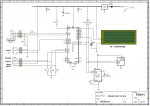I have an AXE133 LCD display (which isn;t working but I will follow the hints here to see if I can make it go) . I do however have another question that hopefully someone can help me with:
I want to connect my lcd to a DS1307 clock (I didn't buy the AXE LCD with attached clock) and was wondering what might be the best way to do this.
Can anyone help?
DDJ
I want to connect my lcd to a DS1307 clock (I didn't buy the AXE LCD with attached clock) and was wondering what might be the best way to do this.
Can anyone help?
DDJ


